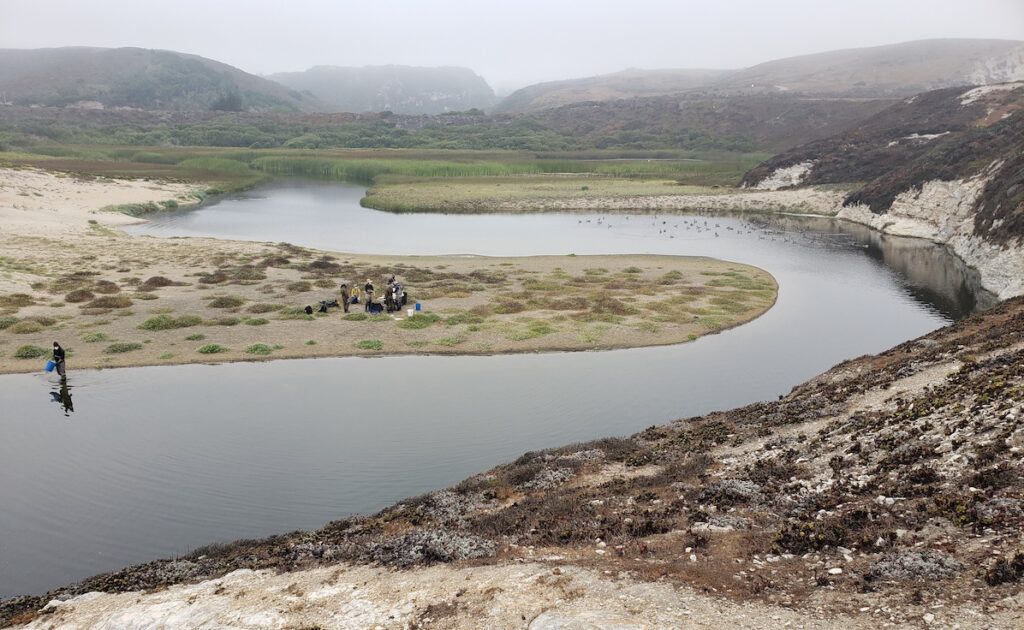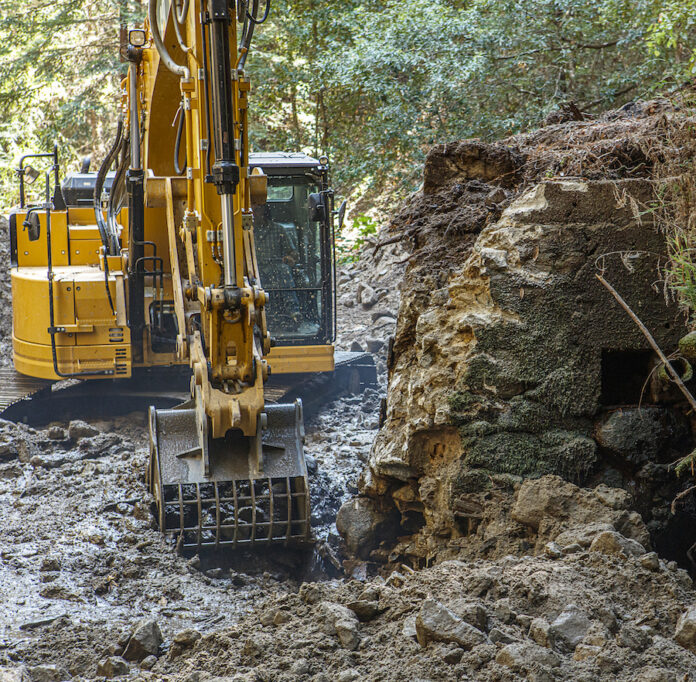They’re an average of eight pounds, with distinct pink scales, and in this area, they’re officially endangered. Local coho salmon have declined more than 95% from their historic population level, according to the Center for Biological Diversity.
The main culprit is the degradation of spawning grounds, such as low river levels due to water being diverted for human use, or dams that block the way upstream. But two recent initiatives—focused on waterways along the North Coast of Santa Cruz County—have sought to help turn the tide.
In one, the Sempervirens Fund, the state’s oldest land trust, spearheaded the removal of an old dam along Mill Creek in the wake of the CZU Lightning Complex fires. In the other, the Santa Cruz Water Department rejigged its water-taking portfolio to allow more liquid to move through Laguna Creek.
The Mill Creek Dam removal story is about breathing life into a beloved watershed, environmentalists say.
“Watershed health is vital to redwood forests,” said Matt Shaffer, Sempervirens Fund’s marketing director. “Watersheds are really land.”
Four conservation organizations own the 8,852-acre San Vicente Redwoods: the Peninsula Open Space Trust, Save the Redwoods League, Land Trust of Santa Cruz County and the Sempervirens Fund, which notes the entire area was consumed by flames, last year.
Davenport’s water lines were also destroyed, including the portion that ran across the top of an old dam on Mill Creek.
The San Vicente watershed is renowned for its karst formations, where dissolving bedrock has left sinkholes and caves, which causes water to rise up from underground. Where Mill Creek empties into the Pacific Ocean at Davenport Beach (via San Vicente Creek), there’s no sandbar or estuary, which means easy access for salmon and steelhead trout, Shaffer explained.
“The conditions are exceptionally good for this watershed to be a good place for spawning,” he said. “It’s very cold water, which is great for salmon. It’s heavy flowing even in the summer.”
However, there’s been a dam in the way.
It’s unclear when Mill Creek Dam was built or what it was supposed to be used for, but it was likely built to serve a rock-mining town called Bella Vista at the turn of the century.
The earliest reference to it was as the “old dam,” in documents about another, further upstream, Shaffer said.
“The dam never worked as intended,” he said. “It was immediately defunct.”
But for more than a century, it blocked fish from passing.
“It could have failed at any time and fallen apart, which would have been a different kind of problem,” he said.
Over the last decade, the Sempervirens Fund installed 13 different wood structures in the creek downstream, to provide salmon with a place to deposit their eggs.
“They capture downflowing debris and create these sandbars,” he said. “It also helps to create a safe haven.”
The Santa Cruz Portland Cement Company started in Davenport in 1906 and later became part of CEMEX, Inc. When CEMEX sold the land on which the dam sits, it kept the water rights—which includes the pipes. So, after the CZU Complex destroyed Davenport’s water infrastructure, Sempervirens saw an opportunity to take ecological action. It asked the company to change the water pipeline’s path.
“The pipe has already been rerouted,” Shaffer said. “That happened very quickly in December, last year.”
In March, Sempervirens Fund got a $550,000 Open Rivers Fund grant from the Resources Legacy Fund, supported by The William and Flora Hewlett Foundation, which was established by Hewlett-Packard co-founder William Redington Hewlett and his wife Flora Lamson Hewlett.
“That set us on a course to get all the work together and get the dam removed,” Shaffer said, noting they had to race against the clock before winter storm season started.
Prior to the dam removal, the Amah Mutsun Land Trust, an initiative of the Amah Mutsun Tribal Band, an Indigenous organization representing the descendants of native people brought to Santa Cruz and San Juan Bautista missions, invited UCLA researchers to study salmon DNA in the creek.
“The salmon were an important food source for Indigenous people in this area prior to colonization,” said Sara French, the organization’s director of development. “Indigenous people had ceremonies to honor the salmon and had annual ceremonies to call the salmon back each year.”
Shaffer says he’s learned plenty from the way the Amah Mutsun Land Trust approaches conservation. French explained they’re blending contemporary resource management practices with Indigenous ecological knowledge. That means returning to traditional practices like selective harvesting and targeting medium-sized fish instead of just harvesting the big ones.
“The UCLA study is using a cutting-edge tool to track the presence or absence of salmon, and their response to the restoration work that’s happening there,” she said.
Work began with professional ecologists moving about 400 plants, like ferns and berry bushes, elsewhere, according to Shaffer. Next, teams went “e-fishing”—meaning they used an electric wand to stun fish so they could be relocated downstream, he said. And on Sept. 21, small and large excavators moved in to do the heavy lifting.
Crews tried to pump water out of the creek so they could get at the dam but were challenged by the karst system continually replenishing the waterway. Eventually, they made enough progress to attack the old pipe and other material forming the barrier.
“They were actually able to begin to break apart the dam wall,” Shaffer said. “We had to move quickly and get going.”
It took about 90 minutes from the first shovel hitting the top of the dam to eliminate it from the ecosystem.
“It looks like nothing, which is exactly what it’s supposed to look like,” he said. “There’s no way to tell that there was ever a dam there.”
Removing the dam and unlocking the upstream sediment was the missing puzzle piece to create perfect conditions for coho spawning, according to Shaffer.
“It’s exceptionally rewarding to be part of this moment in history,” he said. “It’s a historic moment for a very important watershed in the region.”
French says it’s exciting to see progress like this made.
“We are all about restoring pre-colonization conditions,” she said. “These sorts of steps are really important to restoring the natural way of things in the ecosystem.”
Now it’s up to the salmon.

But just a few waterways south, at Laguna Creek, utility officials announced some early success in the wake of another habitat-restoration initiative.
While coho babies hadn’t been spotted in the Laguna Creek lagoon since 2005, that changed in 2020. Now, biologists have recorded 2-year-old coho there, this year.
Chris Berry, watershed compliance manager with the Santa Cruz Water Department, said it was nice to see the City’s voluntary mitigation efforts working.
“Laguna Creek used to be one of the city’s primary drinking water sources,” he said. “The Water Department’s operations have changed a lot.”
It decided to rely less on water from Laguna Creek and draw more from places like the Loch Lomond reservoir, in order to pump the millions of gallons of water it delivers to 98,000 customers, every day.
It used to divert about 6.5 cubic feet per second from Laguna Creek during winter.
“Now we generally take none unless it is a wet year where there is enough water to meet fish needs,” Berry said, adding the lagoon at the outflow lets salmon bulk up before heading out to sea. “It’s a rough world out there in the ocean.”
Juvenile coho documented in recent surveys were 16 to 19 centimeters long, with coloring indicating they were in the early stage of smolting; this suggested they were about to leave the lagoon and become part of the marine environment, utility officials said in a release.
French explained that, because she lives in Santa Cruz, drawing a bath for her daughter has provided teachable moments on the topic of salmon ecology.
Sometimes her daughter, who is now 4, would ask mom to add extra water.
“I say, ‘Nope. We can’t fill it up more. We have to leave it for the salmon,’” she said, adding the message about conserving North Coast streams seems to be sinking in. “She talks about the salmon all the time.”









